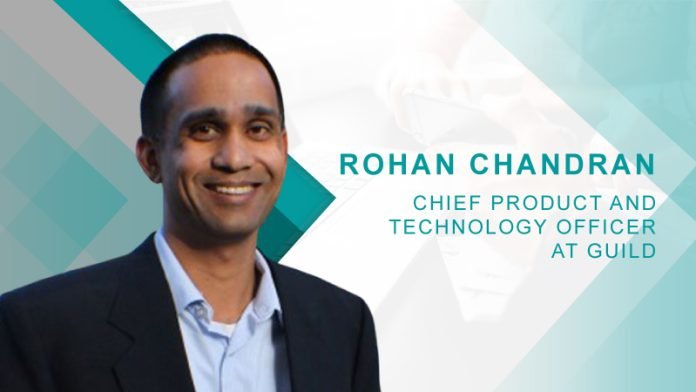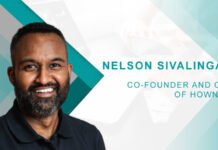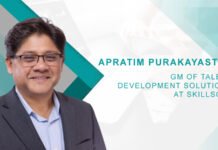Hello Rohan, Can you please give a brief overview of your professional journey, highlighting key milestones that led you to your current role as Chief Product and Technology Officer at Guild?
I believe in product-led transformation and growth, and I’ve always gravitated towards roles where the challenges we were solving through product and engineering could drive a big impact. I spent over two decades across a variety of product management, engineering, and operational leadership roles, helping companies shape their strategies and solve problems worth solving.
I was part of the founding team at CricInfo, which is now part of the ESPN family. I’ve held product and engineering leadership roles at Infonox (now part of Total Systems), Yahoo!, and Experian Interactive.
Most recently I was the Chief Product Officer at Data Axle leading product, technology, data, and operations and prior to that was the Chief Product & Technology Officer at Shopkick.
Guild is known for its focus on creating opportunity across the workforce. How do you see your role as Chief Product and Technology Officer aligning with Guild’s mission to support career advancement and learning opportunities for its members?
I was immediately drawn to Guild as I learned about its mission and realized there’s something phenomenal to help build. We’re transforming the workforce through our product, and technology enables us to do that at scale.
My role is to ensure we’re innovating effectively—that our product is grounded in our mission, builds on our expertise, and continuously drives value for our employer partners while getting ahead of their future workforce needs through strategic skilling tied to their long-term objectives.
I’m here to support and push our teams to constantly be thinking and developing ways to improve the Guild experience for our members, learners, and employer partners. We never want to lose sight of our mission to support employees’ career advancement and employers’ talent strategies; and to deliver on that mission we must make the experience positive for our users.
As the new Chief Product and Technology Officer at Guild, what are your priorities for driving technological innovation and product development to enhance the member experience and address the evolving needs of the workforce?
One of my biggest priorities is to operationalize us as a product and technology organization around the needs of the employers and employees we serve. We’re working to ensure our product innovation and development drives value in the right areas, that we build the right things at the right times, and that those decisions are informed by our ecosystem of members, learners, employer partners, and learning partners.
What we develop must be in service of these stakeholders, and there has to be continuous two-way communication so that we know what matters to them, understand their world and their context, and deliver value against those needs.
Guild recently launched Career Pathways, a career discovery solution aimed at aligning employee learning with companies’ talent needs. Could you provide insights into how this new product capability will impact both employees and employers?
Workforce transformation is top of mind for all HR leaders right now, and that’s not going away. From AI to rapid digital acceleration, the ever-evolving economy presents ongoing challenges for everyone to keep up with. For employers, it’s becoming increasingly challenging to fill in-demand roles and hire for the business’s future needs without a crystal ball – so Career Pathways gives them the ability to tap their existing workforce and truly connect their workforce strategy with their business strategy. We’ve identified pathways, built our Learning Marketplace, and developed career resources with today and tomorrow’s business needs in mind, so leaders know that the skills employees are learning are future-proofed. Of course we built this with employees top of mind, too – we want to guide them towards roles with the highest potential for advancement and success. By connecting employees with learning programs tied to their employers’ most in-demand roles, we’re able to support the career journey long-term.
You’ve mentioned the intrinsic tie between Guild’s product and its mission to create opportunity across the workforce. How do you believe technology enables this connectivity to scale effectively for business impact?
Guild is on a mission to solve big and important problems. It’s estimated that by 2030, the global talent shortage will result in unfilled roles amounting to $8.5 trillion in unrealized annual revenues for companies. Formal labor market participation is historically low, and projected to keep dropping to 60% by 2030.
If companies don’t begin building muscle now on how to scalably build talent and flexibly skill employees, they won’t have any options when the talent pool simply isn’t available. The gap between employees’ potential and their ability to drive business results is access – access to the tools both employers and employees need to connect people to critical roles.
Technology is enabling the connectivity needed and our ability to deliver on our mission at scale. Guild’s Career Opportunity Platform provides millions of American employees access to the learning programs and career support they need to move into in-demand roles at their employers and achieve economic mobility and stability.
With the rise of generative AI and its impact on HR tech, how do you envision Guild leveraging AI technology to enhance its products while avoiding short-sighted decisions that may not serve the long-term interests of the company or its customers?
Within our Career Opportunity Platform™, we’re exploring opportunities to leverage AI to enhance the product experience for employees and employers on both a macro and micro level. For example, leveraging predictive modeling that can help guide employees through their unique career journeys. And for employers, we’re looking at workforce modeling capabilities to help them prioritize and select the best catalog of programs and the right career pathways in order to maximize the business impact of their education benefit.
Internally, we’re tapping AI tools to improve our productivity and execute on operational excellence so that we can best serve our partners.
In today’s rapidly changing landscape, how does Guild empower employees to upskill and adapt to the evolving demands of the workforce, especially in roles impacted by advancements in AI and automation?
We know employers and their employees are eager to build their skills in AI – we saw an 800% jump in applications to our AI programs last year alone. Eight hundred! With so much interest and our understanding of where the workforce is headed, we’re continuing to curate our Learning Marketplace with AI skilling in mind and intentionally providing curated training programs.
Last year we developed our first AI skilling bundle, which honed in on four specific areas of need: focusing on the fundamentals, putting AI in practice, building technical expertise, and strategizing around AI implementation. Together, this ticks every box our employers were asking for, and sets employees up to succeed in an unpredictable future.
Companies don’t want employees to get left behind, and neither do we, which is why we’ve curated our Learning Marketplace and developed our solutions for near and long-term talent needs.
What personal strategies or principles do you rely on to drive innovation and lead technological initiatives within Guild?
I believe a great leader is measured not by the number of followers they have, but by the number of leaders they create. Within the product and technology organization at Guild, I aim to challenge my teams to do hard things, and get them excited about the work. The empowerment of teams is sometimes misconstrued to be laissez-faire management, but it’s really about providing clarity of purpose along with the structure, tools, and systems to enable smart people to think broadly and operate efficiently in order to execute on the team and business’s objectives.
If you help people understand the collective goal around driving innovation, set them up for success, and put your trust in them—they will blow you away.
Based on your experience and insights, what advice would you give to professionals looking to navigate the intersection of technology, workforce development, and career advancement?
There’s a lot of power and value in understanding the context of your company, knowing your unique position and insights, and bringing together stakeholders across the business to optimize your workforce strategy for business success. The advice I’d share with others is:
- Understand the context and bring others along: The context of your company and your position within it are key unlocks for generating value. Get to know your surroundings— the opportunities, the limitations, the internal and external influences—and bring your unique perspective to the table. Importantly, bring other stakeholders across the business along with you and help them understand that workforce development is a business imperative, not just an HR initiative.
- Lead with a learner’s mindset: We’re at a notable inflection point for technology and the workforce. Things change fast, and will only continue to accelerate. Stay abreast of the changing landscape and open to new ways of implementing technology within your organization.
- Get comfortable with discomfort: The old adage that opportunity lies outside your comfort zone is true. Growth comes from challenging ourselves to persevere and see opportunity in areas of discomfort.
- Know that paths aren’t linear: The changes in technology will require agility and the ability to evolve to meet the needs of the workforce. Don’t get lost forging ahead with the original plan, when the best outcome requires charting a new route.
- Leverage technology: Being effective in your work requires implementing the technology, not just understanding it. Knowing how to use new technology, like large language models, to our advantage is more powerful than understanding the mechanics.
- Ikigai: Last, but not least, find a sense of purpose and joy within your work. Workforce transformation is no small feat and has the power to change lives.
In conclusion, what are the key takeaways or messages you’d like to leave our audience with regarding Guild’s commitment to creating opportunity and empowering the workforce through technology-driven solutions?
In our current environment, “The Future of Work” isn’t working for people – and it’s proving to be a problem for business. Guild’s technology-driven solutions are creating a future of work that works for everyone, which depends on access – connecting human potential with the careers that drive business growth.
Explore HRtech News for the latest Tech Trends in Human Resources Technology.

Rohan Chandran, Chief Product and Technology Officer at Guild
Rohan Chandran is the Chief Product & Technology Officer at Guild. Guild enables forward-thinking employers to invest in their employees, unlocking life-changing opportunities for personal and professional growth through education and learning programs, career development, and one-on-one coaching. Chandran is responsible for the company's product and solutions roadmap and strategy, as well as its platform, data, and technology strategies. He was previously the Chief Product Officer at Data Axle and prior to that the Chief Product & Technology Officer at Shopkick. He holds a B.A. in Economics and a B.S. and M.S. in Computer Science from Stanford University.












